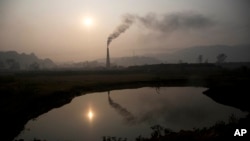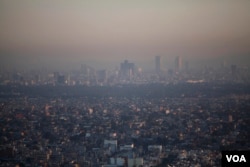At the U.N. climate change conference outside Paris, participants can make up for the greenhouse gases they produced getting there by giving money to a power plant in Chile.
It may sound strange, but it's part of a U.N.-backed system aimed at helping developing countries reduce their greenhouse gas emissions.
The Nueva Aldea Phase 2 power plant in Chile is burning a byproduct of the wood pulping process. It's a form of biomass, a renewable resource with lower carbon dioxide emissions than fossil fuels.
Through the U.N.'s Clean Development Mechanism (CDM), the plant can sell those emissions reductions to polluters elsewhere. And through the U.N.'s recently launched Climate Neutral Now website, those polluters can include attendees who flew to the climate change conference.
Meeting's carbon footprint
Conference organizers have worked to reduce the impact of the event itself. But 40,000 people are descending on Paris from around the world for the meeting. Most of them are flying, burning fossil fuels that create carbon dioxide.
"It would be ironic to have a climate conference to reduce emissions, and what you actually do is you increase them," said Niclas Svenningsen with the U.N.'s climate change secretariat.
So meeting-goers are encouraged to log on to climateneutralnow.org. Svenningsen compares it to the Amazon.com of carbon offsets. It has a calculator so shoppers can compute their share of the carbon dioxide produced by their plane ride. The next step: Go shopping for offsets.
The system is based on the somewhat controversial concept that someone who puts greenhouse gases into the atmosphere can pay someone somewhere else to take them out, or to not produce them.
The most familiar types of offset programs involve planting trees to soak up carbon dioxide. Under the Climate Neutral Now program, offsetters can fund projects intended to prevent other emissions from happening, such as bus rapid transit in Zhengzhou, China; methane capture at a starch plant in Thailand; and wind power in India.
The Nueva Aldea biomass power plant, for example, would not have been built without CDM funds, according to Svenningsen. "This could be a coal-fired plant instead. The difference of your purchase is that they'll actually have a clean energy plant instead of a fossil energy plant."
Imperfections of programs
The site also has a more elaborate calculator that lets users tally their emissions from detailed aspects of their daily lives, such as commuting methods, diet, home heating and so on.
Critics say it's hard to calculate exactly whether these offset programs really do what they advertise. The field has seen problems with sketchy accounting.
Project developers are expected to demonstrate that greenhouse gas reductions would not have happened without carbon offset funds, but opponents say heavy polluters have received offset funding. And some projects have actually caused problems in local communities. Even tree planting projects are not entirely benign, as some have displaced local people.
The U.N.'s offset program is learning from its mistakes, according to Janet Peace at the Center for Climate and Energy Solutions.
"And over time, [they] realized that you actually have to do more,” she said. “And you have to do more of this, and you have to really make sure you're not doing that. And then you've got to have somebody actually check."
She says CDM certification is now among the best available.
"There are very stringent methodologies that in the beginning were not very stringent," Svenningsen acknowledged. "They have now been improved. And the trust and the credibility of these methodologies are much better today than they were in the past."
Room to grow
Others say there is still room for improvement, including better involvement from locals and a way to file grievances if the project does them harm.
And still others compare buying carbon offsets to Catholic priests who once sold indulgences: For a fee, your sins were forgiven. They consider carbon offsets a distraction from what they say should be the real aim: curtailing polluters' emissions.
Svenningsen says offsets are meant as a last resort, not as a replacement to real reductions.
But low carbon energy researcher Niall MacDowell at Imperial College looks at the analogy differently.
"If you could actually commit a sin and then buy an indulgence and wipe it out, that does just get you back to zero, right?” he said. “So, isn't that OK?"











